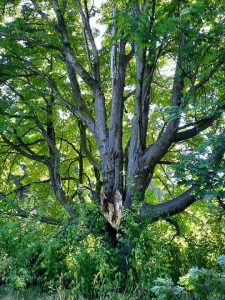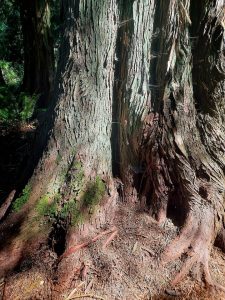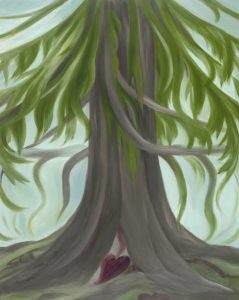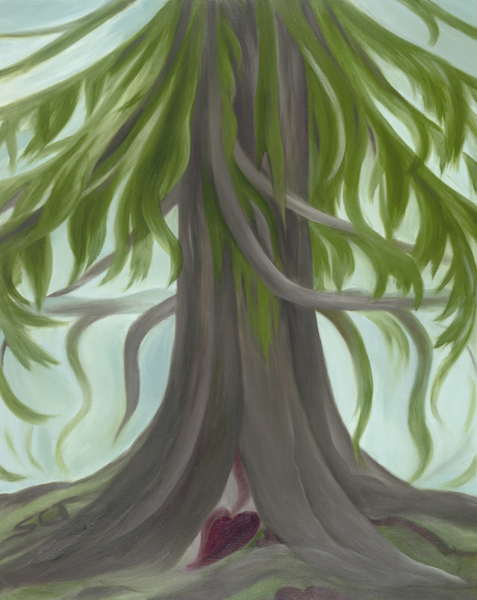by The Rev. Elaine Breckenridge
I have always loved trees. I climbed them as a child. In high school and college, I wrote sentimental poems about them. As an adult, I appreciated trips to arboretums and display gardens. Trees were ornamental. They added interest to my life and beauty in landscapes.
Now however, my relationship with trees has changed. I live on Camano Island, Washington where there are no manicured parks or arboretums. Nor are there any old growth forests that escaped industrial logging. Yet, there are some forests that are protected, or private and undisturbed where I have been spending time.
One day I drove to a nearby nature preserve to walk among the trees. As I walked the familiar path and approached a favorite tree, a very large Big Leaf Maple, I was shocked. It was in a terrible state. There had been high winds that weekend and one of the tree’s huge limbs had been stripped away from its trunk, leaving behind a shocking gash. I found myself speaking to the tree, “I see you. I feel for you. I am sorry for your pain.” At that moment, the tree was calm and steady. It was as if the tree was seeing me and was present to my sorrow. The exposed heart shape conveyed presence to me.

Big Leaf Maple Heart, Four Springs Preserve, Camano Island
After that encounter, I wondered, could it be that trees have the capacity to feel and communicate? Call it mystical or mysterious, real or imagined, I felt that the tree had reached out to me.
Soon after that, I began visiting Madrone trees. Once I encountered a small group of Madrone trees that had been damaged by graffiti. I was grieved to see human initials carved into their beautiful bark. I sat beneath them on the ground and suddenly felt joy. The trees seemed to speak to me. I recorded the experience in my journal and a poem took shape. Here is an excerpt:
A community of madrones welcomes me into their midst.
Even as they hold the sunlight, they hold
me allowing me to be close
to touch limbs which each tell a story.
I see scars made by human initials
carved into their skin. I am angry.
The Wise One speaks, “Come here my dear,
lay an ear against my arm.
Listen and feel the pulse of greening
new skin while peeling
back another layer, shedding my cares below.
You too must practice letting go.”
I study her complex designs and textures,
then see the others dancing with the sky.
“How are you so fluid and flexible?” I ask.
“We never stop moving!” the chorus replies.
“We follow the light. We search for love and joy
even on the darkest days. We look east and
know that the sun will rise.
You should do likewise.”

madrone tree, carved
Clearly, I was inspired by being in the presence of these trees. They sparked my imagination. Were they communicating with me? Or was I projecting human qualities on to these trees? Then I met Susan.
Susan Cohen Thompson is an artist living and working on Camano Island. As I studied her paintings of trees, I saw how human they looked. In her art, she depicts trees not simply swaying in the wind, but dancing! They are portrayed as dynamic and animated creatures. Why? Because Susan understands that trees and forests are sentient beings. As a result of Susan’s art and her friendship, I have come to agree with her. I now know that, in my encounters with trees, I am interacting with sentient beings.
This may sound far-fetched. But recently I read an extraordinary book called, Finding the Mother Tree, Discovering the Wisdom of the Forest by Suzanne Simard. In this book she details her years of study and experiments with trees which led her to uncover some startling secrets about forests. She discovered, along with other scientists, that trees in forests are linked together in a web of interdependence by a system of underground channels composed of roots and fungi. Through these channels, trees perceive, communicate and respond to one another by emitting chemical signals. Furthermore, she learned that older and established trees, “mother trees,” nurture and feed their seedlings and sometimes, trees of no relation. They also pass on wisdom and share their knowledge on how to adapt and survive in changing environments. In the introduction section of her book she writes, “The scientific evidence is impossible to ignore: the forest is wired for wisdom, sentience and healing.”
Note her use of the word forest. The health of trees is dependent upon other trees and plants. The healthiest forests are diverse forests. Much of her work has been aimed at encouraging reforestation efforts to plant multiple species that grow together naturally, rather than developing monoculture stands.
Recently I visited a forest new to me on the island. On private land, this forest is dominated by Western Red Cedar trees. Similar to the forests in British Columbia where Simard did much of her research, this forest is older than many on the island. It is more diverse and I was able to locate the mother tree and could imagine all the connections she had made to other tress surrounding her. Leaning against this mother tree, I recalled what Simard had written. She wrote, “Ecosystems are similar to human societies. They’re built on relationships.”

Mother Tree in East Haven Forest, Camano Island
It appears that we have far more in common with forests and with the Earth than we might think. Her book is a reminder of the ways that all life-forms, including our own, were created by God to be interdependent. Both Celtic Christians and indigenous people of the Earth reverenced creation in ways that we have forgotten. I have learned from both of these traditions that creation is sacred and a theophany or manifestation of God. The Creator, by design, has linked all elements to work together in creation. Nothing exists alone.
I have certainly believed in the principal of interconnectivity on a theological level. Simard’s work is exciting because the science proves it to be true. Her work is hopeful, because by studying forests, we have a path forward to deal with our changing climate.
She writes that it is our disconnectedness and our lost understanding that nature has the capacity to heal and regenerate itself, that causes our despair and helplessness. She believes that trees, plants, and forests will find innovative solutions to deal with climate change. Turning to and “tuning into” the intelligence of nature itself is key.
Praying and worshipping in forests is inviting me to explore a new vocation. I often wince when I see fresh cut tree trunks piled on logging trucks on their way to the mill. How is cutting down the forests in my neighborhood being regulated and managed? What is the reforestation plan? New neighborhoods continue to appear at a steady rate. Does the county on this small island have a cap on population growth? These are questions that I will ask my fellow humans. And, I will continue listening to the heart of the forest speaking, as I seek to be a faithful neighbor and steward of creation, especially forests.

Ancient Rooting, Susan Cohen Thompson
“Ancient Rooting” Painting by Susan Cohen Thompson
And I am grateful. Thanks be to God for the forests of this Earth and how they remind us of the importance of diversity, interdependence and community, both in the human population and in the life, we share on this planet. Thanks be to God for creating trees and forests to be divine messengers, inviting us to reground ourselves in the sacred world of all creation. Thanks be to God that trees and forests have a heart—a heart to heal our Earth. May we listen to their wisdom and allow our forests to flourish.
NOTE: As an Amazon Associate I receive a small amount for purchases made through the link above.

